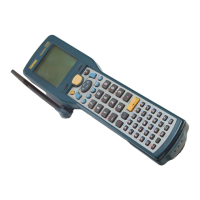Nugg
Co de 39
Running Diagnostics
7-23
7
Serial Port Test
Purpose: Use the Serial Port Test screen to test or troubleshoot serial communications between the
terminal and the host computer or serial device. To run this diagnostic test, you must
connect the terminal to a host or other serial device via the communications dock or
optical link adapter.
Where Available: System Diagnostics menu
Sample Screen:
SERIAL PORT TEST
Select Com. Port:
1,4, Esc : 1
F1:Port Select :1
F2:Keypad Echo : ON
F3:Scanner Echo: ON
F4:Continous TX: OFF
F5:Exit
-
242XU.170
Definition: Press
to test the RS-232 serial communications port. The screen displays the function
key options you can use in this diagnostic screen. You may see the message “Port Not
Available” if your application is currently using the serial port. You need to run an
application that does not use the serial port for this diagnostic test.
F1 Selects the serial port.
F2 Toggles the keypad echo on and off. If you turn the keypad echo on, characters you
type on the keypad are displayed on the bottom line of the screen and transmitted to the
host.
F3 Toggles the scanner echo on and off. If you turn the scanner echo on, the bar code
label you scan is displayed on the bottom line of the screen and transmitted to the host.
F4 Toggles the Continuous Transmit mode on and off. If you turn continuous transmit
on, the terminal continuously sends out a string of 10 characters.
F5 Exits the Serial Port Test diagnostic screen.
On the host, you use an RS-232 serial communications package to receive data from the
terminal. To test serial communications, enter or scan data on the terminal. If the terminal
is communicating with the host, you will see the data. If there is a problem, check the
serial port parameters and make sure they match the host settings. For help with serial
port errors, see Chapter 6, “Troubleshooting,” or contact your local Intermec service
representative.

